Single-Layer Metasurface-Based Reflectarray Antenna with H-Shaped Slotted Patch for X-Band Communication
Abstract
:1. Introduction
2. Design and Analysis of Unit Cell
3. Reflectarray Design and Simulation
4. Results and Discussion
5. Conclusions
Author Contributions
Funding
Data Availability Statement
Conflicts of Interest
References
- Huang, J.; Encinar, J.A. Reflectarray Antennas; John Wiley & Sons: Hoboken, NJ, USA, 2007. [Google Scholar]
- Guo, Y.; Barton, S. Phase efficiency of the reflective array antenna. IEE Proc.-Microw. Antennas Propag. 1995, 142, 115–120. [Google Scholar] [CrossRef]
- Li, L.; Chen, Q.; Yuan, Q.; Sawaya, K.; Maruyama, T.; Furuno, T.; Uebayashi, S. Frequency selective reflectarray using crossed-dipole elements with square loops for wireless communication applications. IEEE Trans. Antennas Propag. 2010, 59, 89–99. [Google Scholar] [CrossRef]
- Gupta, A.; Kumari, M.; Sharma, M.; Alsharif, M.H.; Uthansakul, P.; Uthansakul, M.; Bansal, S. 8-port MIMO antenna at 27 GHz for n261 band and exploring for body centric communication. PLoS ONE 2024, 19, e0305524. [Google Scholar] [CrossRef] [PubMed]
- Sharma, K.; Karmakar, A.; Prakash, K.; Chauhan, A.; Bansal, S.; Hooda, M.; Kumar, S.; Gupta, N.; Singh, A.K. Design and characterization of RF MEMS capacitive shunt switch for X, Ku, K and Ka band applications. Microelectron. Eng. 2020, 227, 111310. [Google Scholar] [CrossRef]
- Gupta, A.; Kumar, V.; Bansal, S.; Alsharif, M.H.; Jahid, A.; Cho, H.S. A Miniaturized Tri-Band Implantable Antenna for ISM/WMTS/Lower UWB/Wi-Fi Frequencies. Sensors 2023, 23, 6989. [Google Scholar] [CrossRef]
- Pozar, D. Bandwidth of reflectarrays. Electron. Lett. 2003, 39, 1490–1491. [Google Scholar] [CrossRef]
- Li, Y.; Li, L. Broadband microstrip beam deflector based on dual-resonance conformal loops array. IEEE Trans. Antennas Propag. 2014, 62, 3028–3034. [Google Scholar] [CrossRef]
- Min, M.; Guo, L.; Feng, W. A Wideband Reflectarray Using Slotted Patch with Concave Arms. In Proceedings of the 2020 14th European Conference on Antennas and Propagation (EuCAP), Copenhagen, Denmark, 15–20 March 2020; IEEE: New York, NY, USA, 2020; pp. 1–3. [Google Scholar]
- Chen, Q.Y.; Qu, S.W.; Li, J.F.; Chen, Q.; Xia, M.Y. An X-band reflectarray with novel elements and enhanced bandwidth. IEEE Antennas Wirel. Propag. Lett. 2013, 12, 317–320. [Google Scholar] [CrossRef]
- Encinar, J.A. Design of two-layer printed reflectarrays using patches of variable size. IEEE Trans. Antennas Propag. 2001, 49, 1403–1410. [Google Scholar] [CrossRef]
- Encinar, J.A.; Zornoza, J.A. Broadband design of three-layer printed reflectarrays. IEEE Trans. Antennas Propag. 2003, 51, 1662–1664. [Google Scholar] [CrossRef]
- Carrasco, E.; Encinar, J.A.; Barba, M. Bandwidth improvement in large reflectarrays by using true-time delay. IEEE Trans. Antennas Propag. 2008, 56, 2496–2503. [Google Scholar] [CrossRef]
- Ahmad, A.; Ali, J.; Choi, D.Y. Investigating Polarization-Sensitive Transmission and Reflection. Appl. Sci. 2023, 13, 10389. [Google Scholar] [CrossRef]
- Khan, D.; Ahmad, A.; Choi, D.Y. Dual-band 5G MIMO antenna with enhanced coupling reduction using metamaterials. Sci. Rep. 2024, 14, 96. [Google Scholar] [CrossRef] [PubMed]
- Ali, J.; Ahmad, A.; Choi, D.y. A Metalens design for on-and off-center focusing with amorphous silicon hydrogenated (a-Si: H)-based 1D array in visible spectrum. Electronics 2023, 12, 2953. [Google Scholar] [CrossRef]
- Qin, P.Y.; Guo, Y.J.; Weily, A.R. Broadband reflectarray antenna using subwavelength elements based on double square meander-line rings. IEEE Trans. Antennas Propag. 2015, 64, 378–383. [Google Scholar] [CrossRef]
- Yang, Z.; Zhang, J.; Liu, Y.; Zhang, W.; Zhang, Q.; Gao, Y.; Tong, Z. A novel wideband reflectarray using sub-wavelength Archimedes spiral unit cell. Electromagnetics 2022, 42, 411–424. [Google Scholar] [CrossRef]
- Liao, T.; Zhang, Z.Q.; Jiao, Y.C.; Yan, Y.D.; Chen, G.T.; Weng, Z.B. Broadband circular polarized reflectarray based on multi-resonance unit. Int. J. RF Microw. Comput.-Aided Eng. 2021, 31, e22618. [Google Scholar] [CrossRef]
- Vosoogh, A.; Keyghobad, K.; Khaleghi, A.; Mansouri, S. A high-efficiency Ku-band reflectarray antenna using single-layer multiresonance elements. IEEE Antennas Wirel. Propag. Lett. 2014, 13, 891–894. [Google Scholar] [CrossRef]
- Yu, H.; Guo, L. Broadband single-layer reflectarray antenna employing circular ring elements dented with sectorial slits. IEEE Access 2019, 7, 165814–165819. [Google Scholar] [CrossRef]
- Han, C.; Zhang, Y.; Yang, Q. A broadband reflectarray antenna using triple gapped rings with attached phase-delay lines. IEEE Trans. Antennas Propag. 2017, 65, 2713–2717. [Google Scholar] [CrossRef]
- He, Y.; Gao, Z.; Jia, D.; Zhang, W.; Du, B.; Chen, Z.N. Dielectric metamaterial-based impedance-matched elements for broadband reflectarray. IEEE Trans. Antennas Propag. 2017, 65, 7019–7028. [Google Scholar] [CrossRef]
- Su, W.; Luo, W.; Nie, Z.; Liu, W.W.; Cao, Z.H.; Wang, Z. A wideband folded reflectarray antenna based on single-layered polarization rotating metasurface. IEEE Access 2020, 8, 158579–158584. [Google Scholar] [CrossRef]
- Mao, Y.; Xu, S.; Yang, F.; Elsherbeni, A.Z. A novel phase synthesis approach for wideband reflectarray design. IEEE Trans. Antennas Propag. 2015, 63, 4189–4193. [Google Scholar] [CrossRef]
- Pozar, D. Wideband reflectarrays using artificial impedance surfaces. Electron. Lett. 2007, 43, 1. [Google Scholar] [CrossRef]
- Ahmad, A.; Choi, D.Y. Design, optimization, and comparative analysis of wide-band polarization conversion along with dual coding sequences for RCS reduction. Sci. Rep. 2024, 14, 8262. [Google Scholar] [CrossRef] [PubMed]
- Ahmad, A.; Choi, D.y. Compact eight-element MIMO antenna with reduced mutual coupling and beam-scanning performance. Sensors 2022, 22, 8933. [Google Scholar] [CrossRef]
- Kundu, D.; Bhattacharya, D.; Ruchi, R. A single-layer broadband reflectarray in k-band using cross-loop slotted patch elements. IEEE Access 2022, 10, 13490–13495. [Google Scholar] [CrossRef]
- Güneş, F.; Demirel, S.; Nesil, S. A novel design approach to X-band Minkowski reflectarray antennas using the full-wave EM simulation-based complete neural model with a hybrid GA-NM algorithm. Radioengineering 2014, 23, 144–153. [Google Scholar]
- Lee, S.R.; Lim, E.H.; Lo, F.L. Broadband single-layer E-patch reflectarray. Radioengineering 2017, 26, 97–106. [Google Scholar] [CrossRef]
- Qotolo, S.F.; Hassani, H.R.; Naser-Moghadasi, M. A novel broadband reflectarray antenna with lattice stubs on square element for K u-band application. Microw. Opt. Technol. Lett. 2015, 57, 2699–2702. [Google Scholar] [CrossRef]
- Pan, Y.; Zhang, Y. Analysis of Blockage Effects in a Center-Fed Reflectarray. Microw. Opt. Technol. Lett. 2013, 55, 1921–1926. [Google Scholar] [CrossRef]
- Wang, Z.; Zhang, R.; Song, W.; Lin, X.; Xie, B.; Wang, J.; Zhao, R. W-band single-layer broadband reflectarray antenna. IEEE Access 2023, 11, 66309–66317. [Google Scholar] [CrossRef]
- Shabbir, T.; Saleem, R.; Rehman, S.U.; Shafique, M.F. Single layer reflectarray antenna with pie-shaped elements for X-band applications. Appl. Comput. Electromagn. Soc. J. (ACES) 2018, 33, 1230–1235. [Google Scholar]
- Han, C.; Zhang, Y.; Yang, Q. A novel single-layer unit structure for broadband reflectarray antenna. IEEE Antennas Wirel. Propag. Lett. 2016, 16, 681–684. [Google Scholar] [CrossRef]
- Bodur, H.; Cimen, S. Reflectarray antenna design with double cutted ring element for X-band applications. Microw. Opt. Technol. Lett. 2020, 62, 3248–3254. [Google Scholar] [CrossRef]
- Su, T.; Yi, X.; Wu, B. X/Ku dual-band single-layer reflectarray antenna. IEEE Antennas Wirel. Propag. Lett. 2019, 18, 338–342. [Google Scholar] [CrossRef]
- Shabbir, T.; Islam, M.T.; Misran, N.; Al-Bawri, S.S.; Singh, S. Broadband single-layer reflectarray antenna loaded with meander-delay-lines for X-band applications. Alex. Eng. J. 2021, 60, 1105–1112. [Google Scholar] [CrossRef]
- Etesami, F.; Abiri, H.; Khorshidi, S. Design of a broadband single-layer reflectarray antenna using double hexagonal rings and a hexapole. J. Electromagn. Waves Appl. 2020, 34, 2419–2432. [Google Scholar] [CrossRef]
- Nayeri, P.; Yang, F.; Elsherbeni, A.Z. Beam-scanning reflectarray antennas: A technical overview and state of the art. IEEE Antennas Propag. Mag. 2015, 57, 32–47. [Google Scholar] [CrossRef]
- Shabbir, T.; Saleem, R.; Rehman, S.U.; Shafique, M.F. A compact single layer reflectarray antenna based on circular delay-lines for X-band applications. Radioengineering 2018, 27, 440–447. [Google Scholar] [CrossRef]
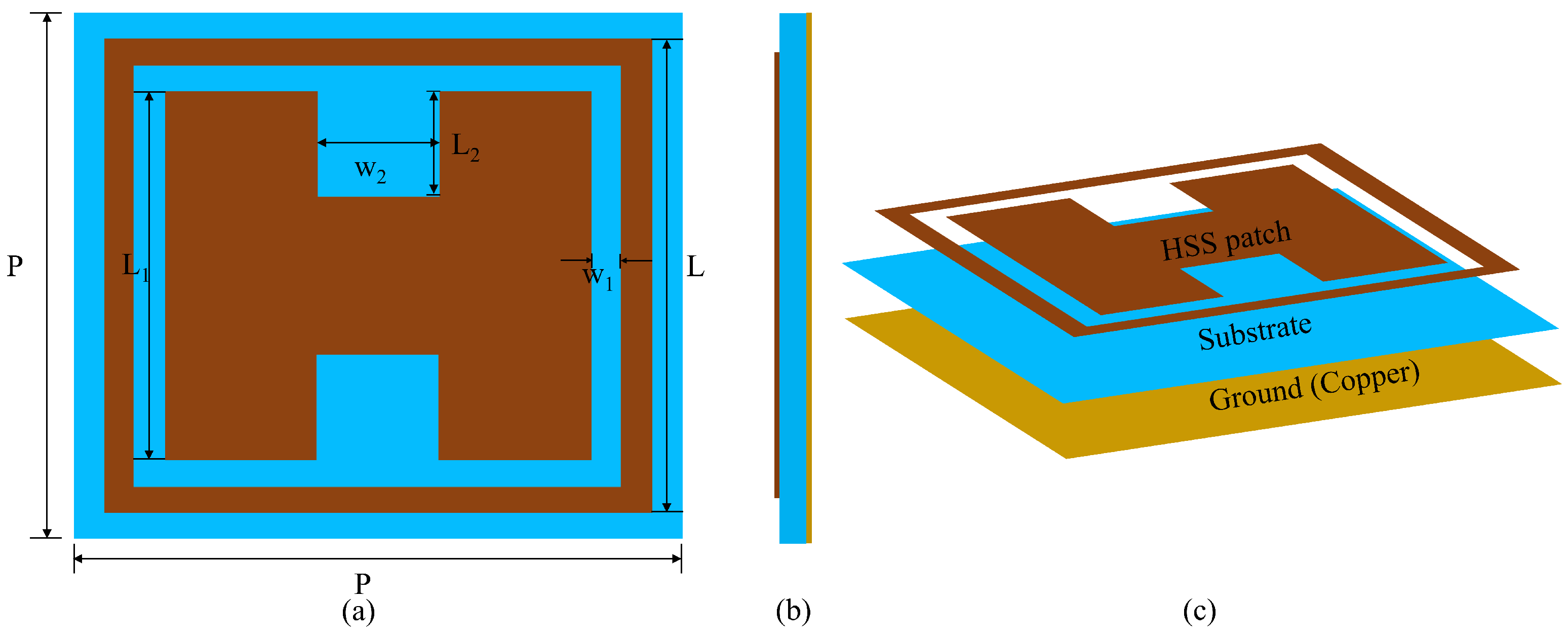

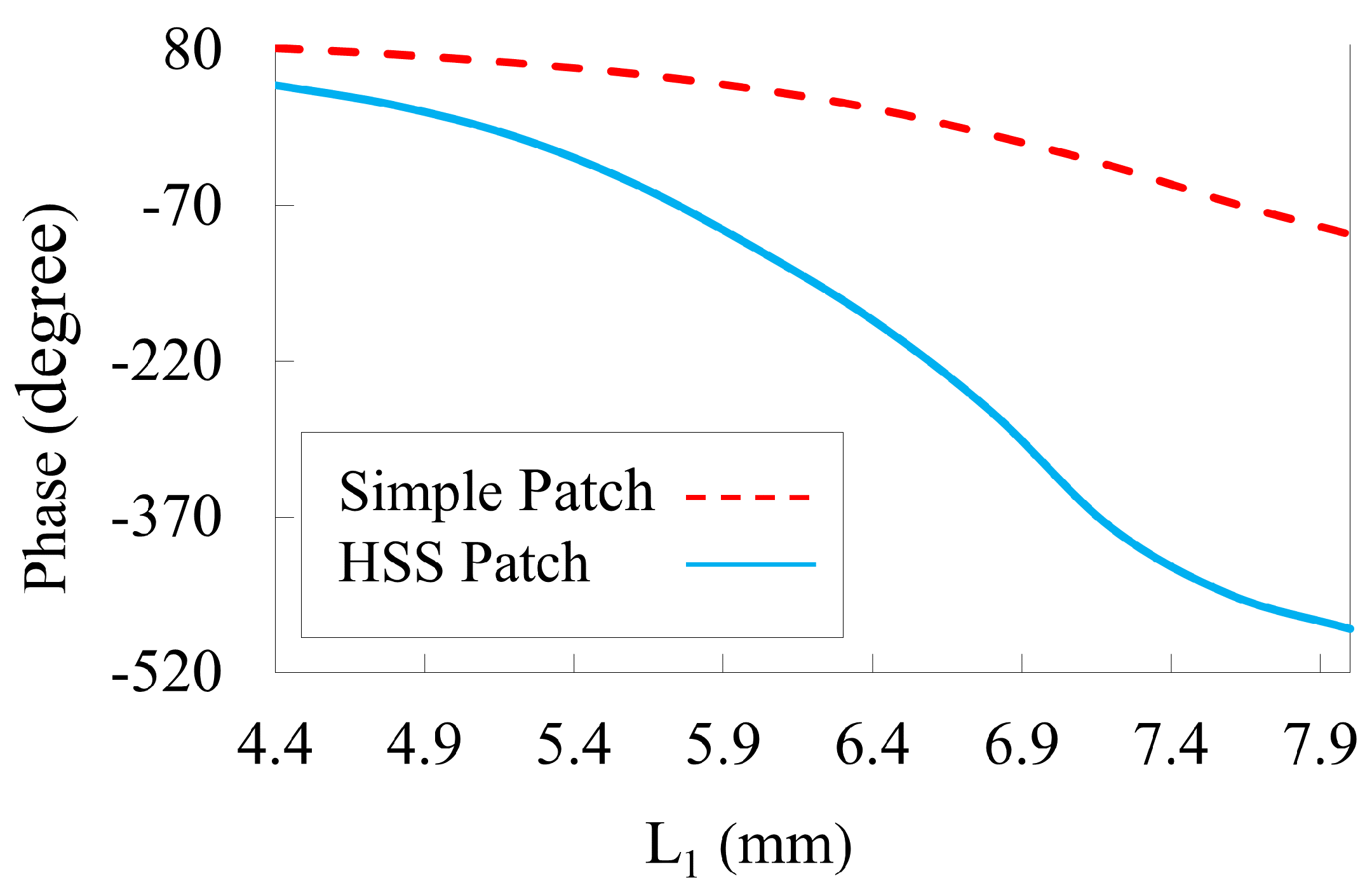
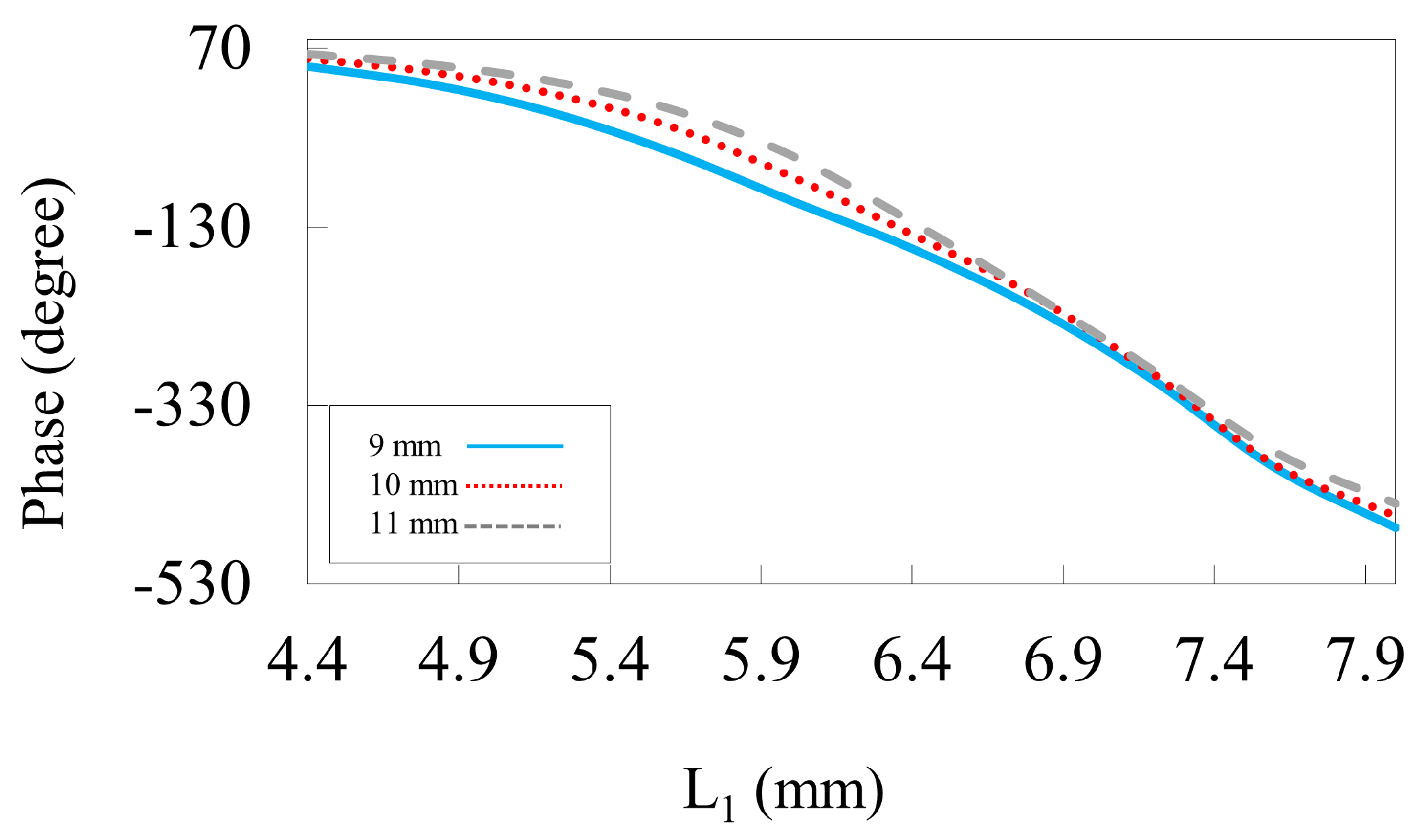
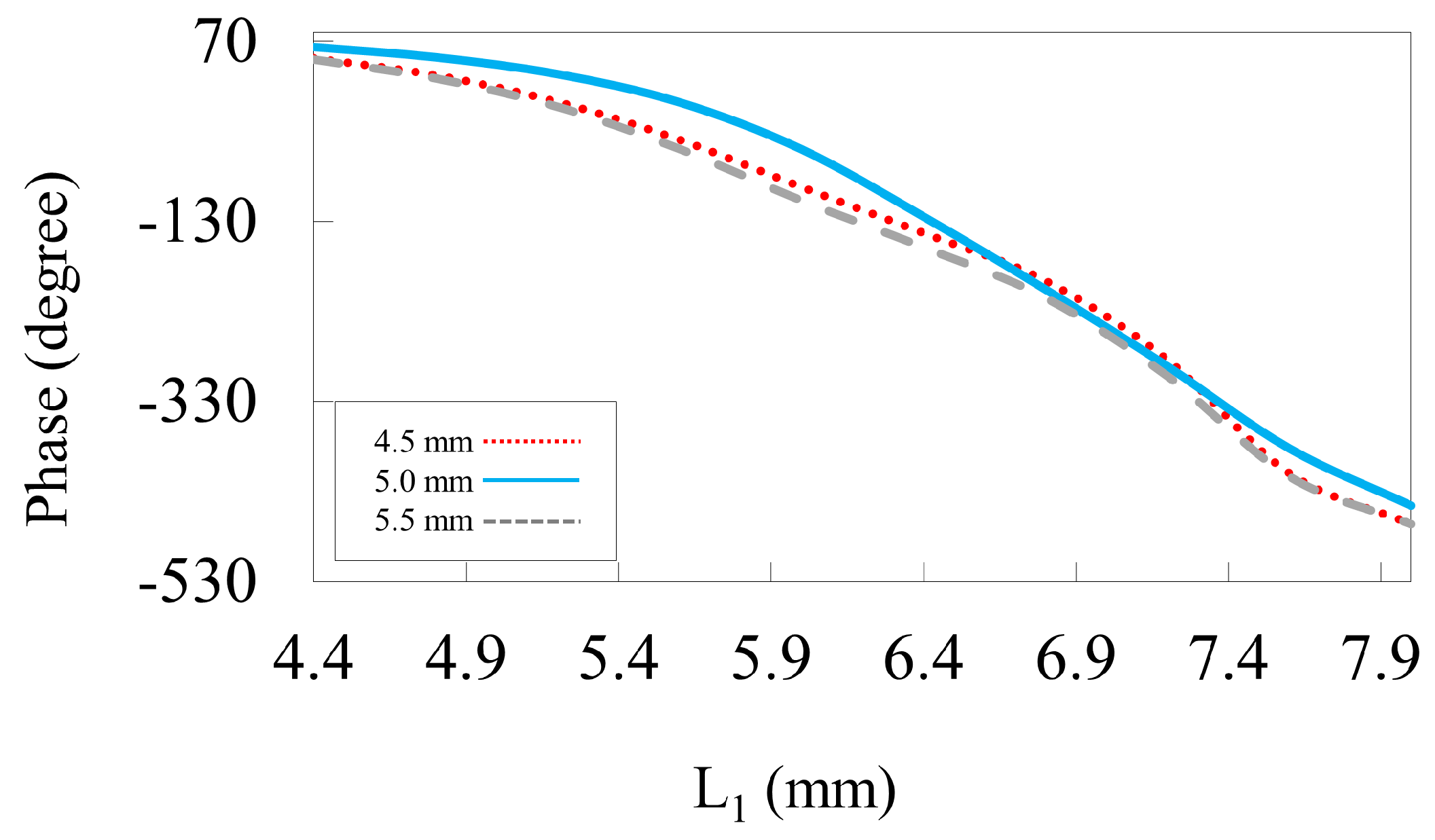
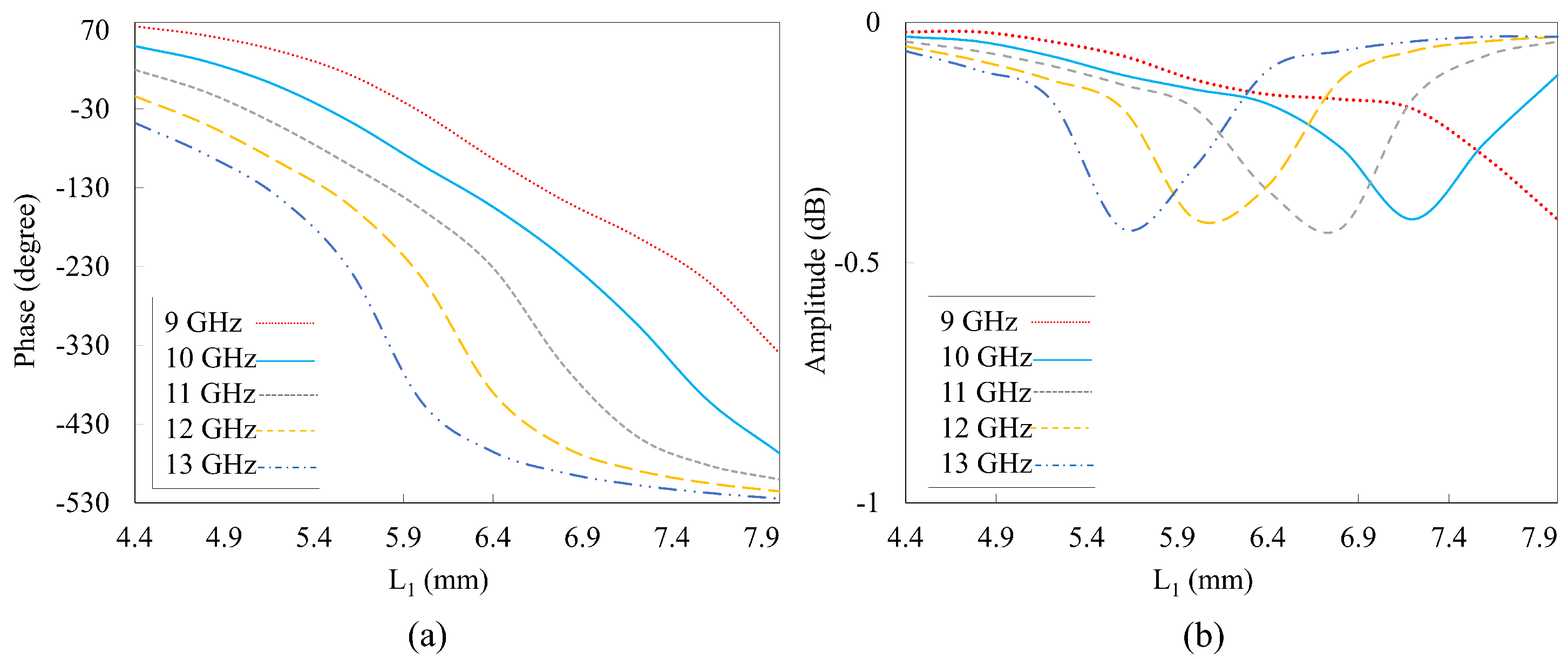
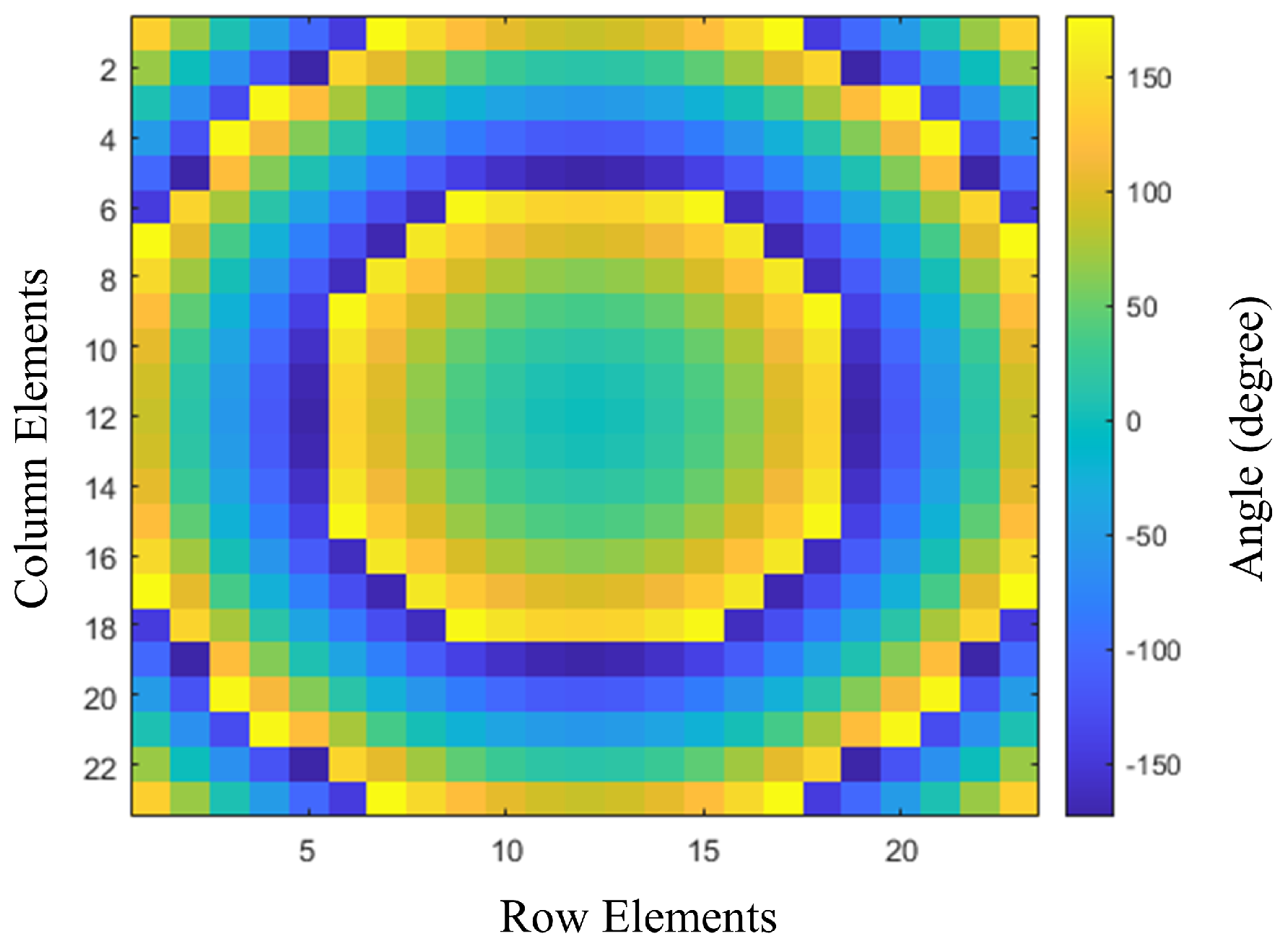
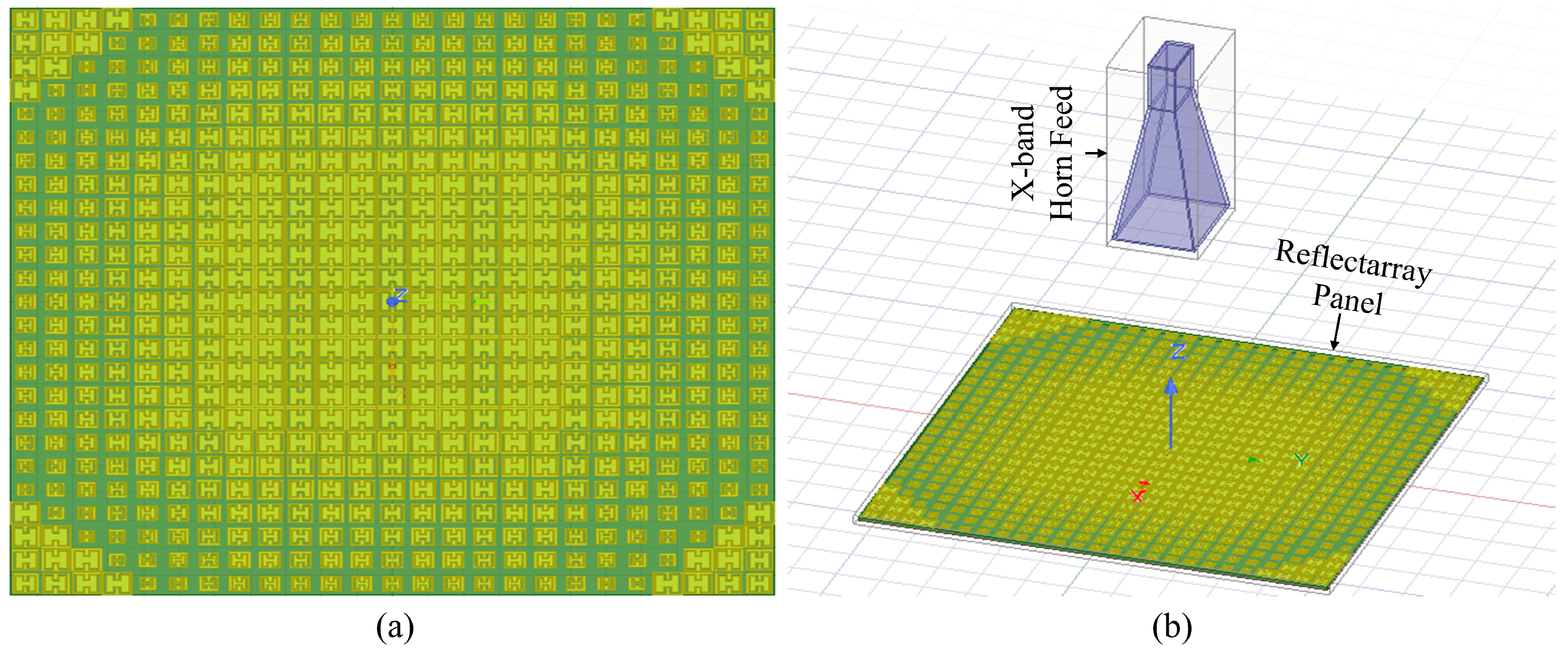

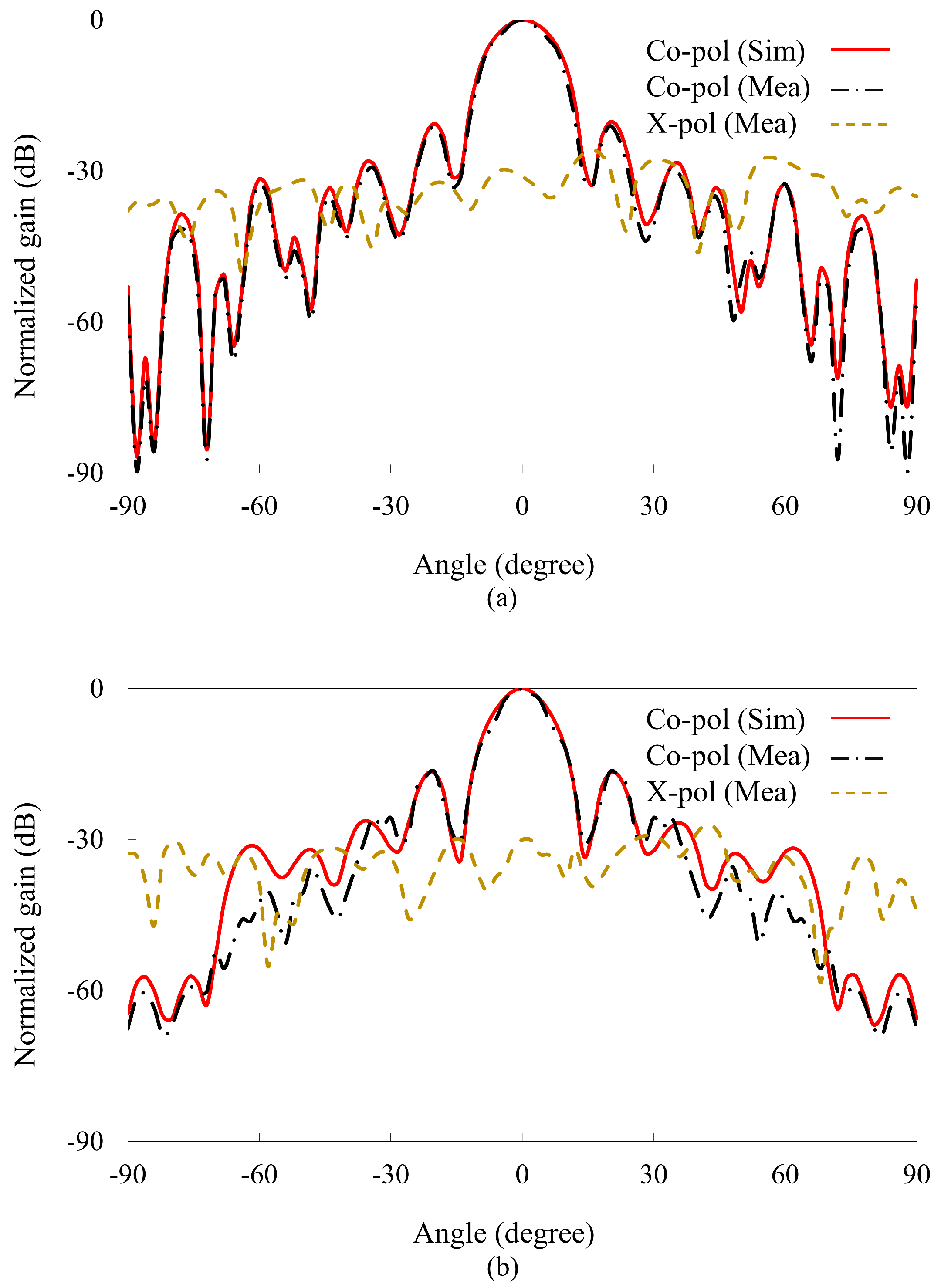

| Parameter | P | L | |||
|---|---|---|---|---|---|
| Values | 9 mm | 8–4.4 mm | 6.4–2.4 mm | 0.5 mm | 2 mm |
| References | This Work | [27] | [28] | [29] |
|---|---|---|---|---|
| Center frequency (GHz) | 10 | 10 | 10 | 10 |
| Gain (dBi) | 25.5 dBi | 24 dBi | 25 dBi | 22.8 dBi |
| Aperture efficiency (%) | 63.7% | 48% | 52.8% | 32% |
| 1 dB Bandwidth (%) | 20% | 18% | 19.5% | - |
| Side lobe levels (SLLs) | −21 | −22 | −22 | −14 |
| X-pol (dB) | −33 | −35 | −35 | −25 |
| Air layer | No | Yes | Yes | No |
Disclaimer/Publisher’s Note: The statements, opinions and data contained in all publications are solely those of the individual author(s) and contributor(s) and not of MDPI and/or the editor(s). MDPI and/or the editor(s) disclaim responsibility for any injury to people or property resulting from any ideas, methods, instructions or products referred to in the content. |
© 2024 by the authors. Licensee MDPI, Basel, Switzerland. This article is an open access article distributed under the terms and conditions of the Creative Commons Attribution (CC BY) license (https://creativecommons.org/licenses/by/4.0/).
Share and Cite
Ali, J.; Ahmad, A.; Choi, D.-y. Single-Layer Metasurface-Based Reflectarray Antenna with H-Shaped Slotted Patch for X-Band Communication. Nanomaterials 2024, 14, 1495. https://doi.org/10.3390/nano14181495
Ali J, Ahmad A, Choi D-y. Single-Layer Metasurface-Based Reflectarray Antenna with H-Shaped Slotted Patch for X-Band Communication. Nanomaterials. 2024; 14(18):1495. https://doi.org/10.3390/nano14181495
Chicago/Turabian StyleAli, Jawad, Ashfaq Ahmad, and Dong-you Choi. 2024. "Single-Layer Metasurface-Based Reflectarray Antenna with H-Shaped Slotted Patch for X-Band Communication" Nanomaterials 14, no. 18: 1495. https://doi.org/10.3390/nano14181495






